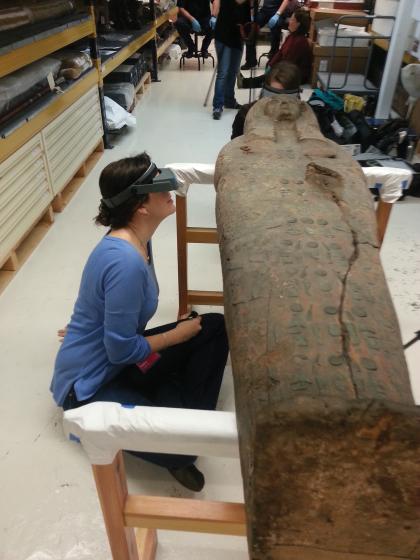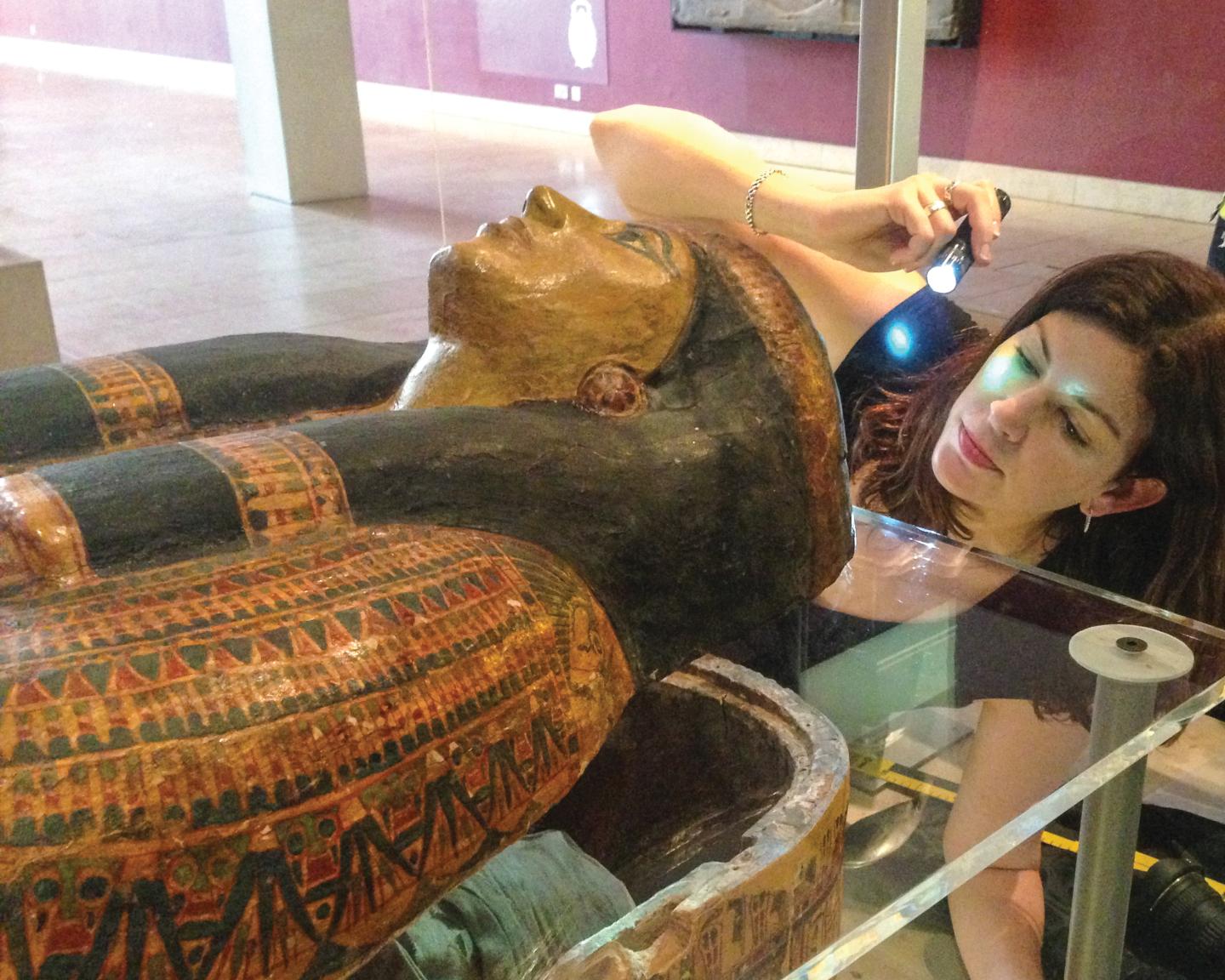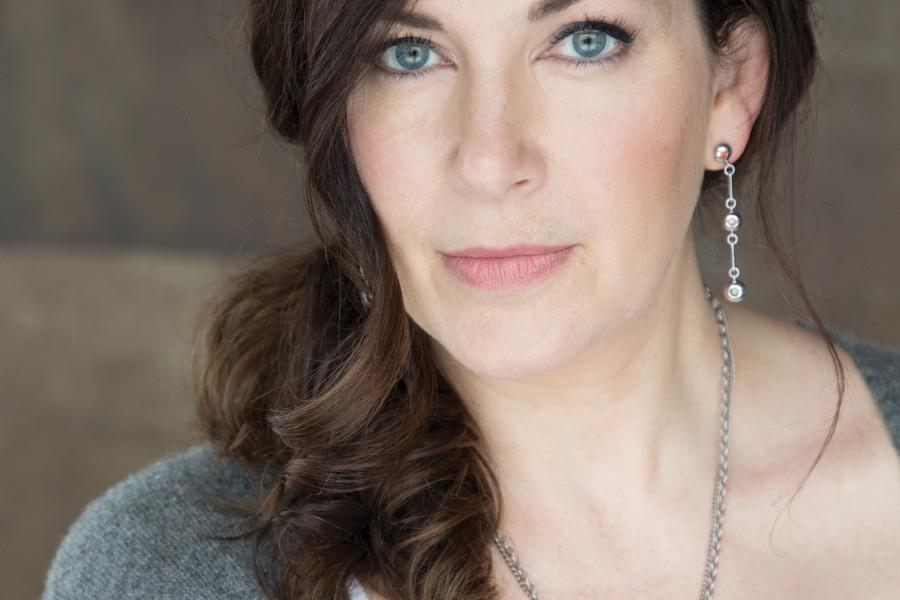It's the rare scholar who can write incisive academic papers for peers as well as popular, page-turning books for the public. Even rarer is the person who gets away with comparing Egyptian pharaohs to Joseph Stalin, John Kennedy, and Ronald Reagan. But then few are like Kara Cooney, A&S '02 (PhD).
For 25 years, Cooney has challenged long-held narratives about Egypt's past, ones largely built on chariot battles and Moses leading his people out of bondage. And, of course, pyramids.
Cooney, now a professor of Egyptian art and architecture at UCLA and chair of its Department of Near Eastern Languages and Cultures, instead trains her astute eye on Egypt's lesser-told stories—like that of the six women who reigned amid the lineage of 170 men during the empire's 3,000-year existence. Her book When Women Ruled the World: Six Queens of Egypt (National Geographic, 2018) "provides welcome insights into pharaonic politics while bringing numerous little-known Egyptian women to the fore," according to Kirkus Reviews.

Image credit: Photograph Courtesy of UCLA Coffins Project
"The Egyptians were light-years ahead of us in their trust of female power," Cooney explains in the book. "Ancient Egyptian monarchs proved that women do rule differently. They didn't demand hundreds of lovers to sexually service them, like Harvey Weinstein or a king in his harem. They ruled on behalf of family members, not just for themselves. For the most part, they avoided war, rather than jumping into the melee. And they were called upon precisely when their people were at their most vulnerable."
In her follow-up book, The Good Kings: Absolute Power in Ancient Egypt and the Modern World (National Geographic, 2021), Cooney draws parallels between male pharaohs and present-day authoritarians. The uncritical admiration of male pharaohs that has continued to the present day, both in her field and in the public's estimation, represents a legacy of the ancient rulers' efforts to manipulate how they were perceived. She ponders in her book whether our continued obsession might be a symptom "of an ongoing addiction to male power that we just can't kick?"
In the academic realm, using her formal name, Kathlyn M. Cooney, she writes scholarly works such as The Cost of Death: Social and Economic Value of Ancient Egyptian Funerary Art in the Ramesside Period (Nederlands Instituut voor het Nabije Oosten, 2007) and Recycling for Death: Coffin Reuse in Ancient Egypt and the Theban Royal Caches (The American University in Cairo Press, forthcoming). In Recycling for Death, she gets as detailed as a pathologist's autopsy report when describing coffins.
Cooney is a firebrand among Egyptologists, one whose books and research have rankled fellow scholars, including some who believe that grafting a modern-day lens on Egypt's history is a bridge too far. "They're rather slavish to authoritarian systems," Cooney says of the naysayers. "Instead of criticizing the ancient Egyptian system at all, they celebrate it and work too easily with the modern Egyptian government."
Ask Cooney today what people think of her, and she replies with a laugh. "If you go to a conference of Egyptologists and ask, 'What is Kara Cooney known for?' you might find I'm known for stirring things up."
That desire to stir things up has a goal, though.
"Kara has broken the mold for Egyptologists by blending hardcore scholarly pursuits with pursuits that are more in the general public sphere," says Melinda Hartwig, a curator of ancient Egyptian, Nubian, and Near Eastern art at Emory University's Michael C. Carlos Museum. "She's done a great service to the field by getting people more excited about ancient Egypt."
Whether it's through her widely read books, her academic papers, or her many appearances on popular documentaries and television shows, Cooney is on a mission: To usher in a fresh understanding of Egypt, and of ourselves, by illuminating the ways in which our contemporary lives echo the past.
"An emotional calling."
That's how Cooney describes her passion for Egyptology. Beyond that, she says she can't quite explain its fascination, though she admits what surrounded her during her affluent childhood in Houston—"big hair, big cars, expensive things"—likely had something to do with it. "Those were things I rejected, and in rejecting them, my academic interests came to the fore," she says. "That I was able to take that part of myself that was already very skeptical about this late capitalist world and put it into academic study was very useful."
Cooney has made dozens of trips to Egypt over her years of study, most recently in 2022: but she remembers well the trips she took when studying at Hopkins. The art and science of analyzing mummies and bandages was something Cooney began to learn as a grad student around the turn of the millennium while studying under thesis adviser Betsy Bryan, now a Johns Hopkins professor emerita of Egyptian art and archaeology. During one archaeological field study with Bryan at Egypt's largest concentration of private tombs, the massive burial site Sheikh Abd el-Qurna near Luxor's Valley of the Kings, she went down into a 20-foot shaft to spend days in a low-ceilinged burial chamber with only a headlamp.
Cooney has since spent two decades studying the burial habits of Egyptians, becoming an expert in 19th- and 21st-Dynasty Egyptian funerary practice. She began studying coffins, in particular, because she thought they could offer valuable insights. "Coffins are social documents, recording social place, gender, spending ability, geographic place, commodity availability, craft details, and religious information," Coffey wrote in a 2018 paper. "Coffins can reflect human reactions to all sorts of changes in the environment and within human systems, including reactions to scarcity and crisis."
Coffins are often in like-new condition, thanks to Egypt's dry climate, and most of the ones that she has inspected over the years were made for elite Egyptians during the 19th and 20th Dynasties (the reigns of Ramses I through Ramses XI from 1295 BC to 1069 BC).
Cooney's research has been aided by the existence of thousands of bills, contracts, and letters left by coffin artisans of the village Deir el-Medina near the Valley of the Kings. In her book Coffin Commerce: How a Funerary Materiality Formed Ancient Egypt (Cambridge University Press, 2021), Cooney likens her time-traveling research to that of an archaeologist in the year 5000 "trying to reconstruct the economic system of a small Texas town of 2000—thousands of years after the United States has ceased to exist, thousands of years after people had stopped using American English—using only the archaeological site of a big-box store called Walmart, in an industrial area meant for petrochemical operations with a few offices and homes intact, accompanied by millions of scraps of paper that managed to survive because the town was in a very arid location."
She estimates that she has inspected about 450 coffins that had been unearthed at western Thebes, Asyut, and at the necropolis of Saqqara, at Memphis. Today, far from dusty digs, she is an object specialist who dons a pair of old jeans and studies these coffins with an iPad in the basements of the Louvre, the Vatican Museums, the British Museum, and the Museo Egizio in Turin, Italy.
Her encounters with these materials are monitored and brief. She's rarely given more than two days for her analysis, so she moves quickly and always under a curator's watchful eye. She and her team of seven had only three hours to scrutinize the coffin of Ramses II, for instance, at Cairo's Egyptian Museum. "It was like, you shoot this. You shoot that. You do the lid. You do the trunk. I'm gonna do the reuse study. Somebody else is gonna get the magnifying light. The microscopic analysis? Somebody else will do that," she says. Cooney has scrutinized so many coffins that she can often tell at a glance how old one is.

Image credit: Photograph Courtesy of UCLA Coffins Project
Cooney was among the first to do such coffin research. Not all her colleagues appreciated the value of this academic inquiry. When she was a young scholar, she delivered a paper on coffin reuse at a conference and a colleague sniffed, "Kara, what a very imaginative paper," to which Cooney replied, "Which part do you think I imagined?"
Coffin studies have now significantly increased, and she defends young scholars who are also intrigued by this research. "I was on a dissertation committee for a grad student working on coffins," she recalls, "and a professor said, 'Oh, my God, another study on coffins! Please, can we stop this?'"
Cooney shot back, "That would be like saying, 'Oh, another study on Attic [ancient Greek] vases! Can we please stop with this?' Each of these objects is representative of a range of social questions and issues."
In 2011, Cooney published what she called "the first study to systematically identify evidence of coffin reuse in any time period in ancient Egypt," as she wrote, "and the findings continue to surprise Egyptologists." During times of scarcity, owing to war or economic upheaval, Egyptians began to repurpose coffins, creating new burial boxes out of existing ones. More of this research has been compiled for her forthcoming book, Recycling for Death.
Countless generations of Egyptian elites commissioned grand tombs to bury mummified loved ones. They believed that human-shaped coffins transmogrified their dead into godlike forms that would live for eternity. With their features painted on coffin lids, eyelids open, smiling in defiance of death, these Bronze Age immortals, cozy in their capsules, were as suited up and ready for the great beyond as astronauts.
As a grad student under Bryan, Cooney explored Theban Tomb 92, which was carved into a barren rock cliff face for Suemniut, the cupbearer of Amenhotep II, the seventh pharaoh of the 18th Dynasty of Egypt. His reign came near the midpoint of an empire that lasted three millennia, from 3150 BC to 31 BC, an expanse that dwarfs America's 247 years. Two hundred years after Suemniut last prepared his master's food and fed his royal person, Egypt fell on hard times and was beset for decades by invaders. Wood grew scarce, and Suemniut's descendants reused the tomb and coffins many times.
Hundreds of years later, thieves ripped open coffins, peeled away their gold leaf embellishments, pulling mummies apart. They tore through mummy wrappings to snatch amulets and other treasures, leaving a whirlwind of wreckage. But in contrast, coffin reuse itself was a loving act, not a desecration, according to Cooney. The coffinless dead were left in tombs, rituals were conducted to appease their spirits, and artisans refurbished their coffins for new users.
Cooney compares the practice to brides preserving their wedding dresses to give to their daughters. "Because they were in the desert, Egyptians had to confront death by putting their dead away and keeping them at the same time. They had to make friends with them in a way we don't have to," she says.
Coffin reuse was also a way of showing the community how important one's family was, Cooney adds. She believes it was the only moral solution because the person who had been transformed no longer needed the coffin as a vehicle for that purpose.
Further explaining the importance of coffins in ancient Egyptian society, in Coffin Commerce, she dubs the coffin-making business back then "the mortuary industrial complex," likening Deir el-Medina's craftsmen to Lockheed Martin engi- neers working under Department of Defense con- tracts. "[The artisans] could not talk to anyone about the iconography and texts they were inscrib- ing onto the tomb walls [of royals]. ... They knew too much. They were, in a sense, 'the deep state' that the king needed to keep happy," she writes.
Cooney views these coffins as a means of conspicuous consumption, deeming them "social wedges" for elites who used—and reused—them to prove their affluence was divinely given. "We need to start looking at all this stuff and go, 'Wait a minute, who owns it? Who's got to have it? Who was hurt by somebody else taking that tree to make that coffin? Was that a tree they got shade from in their village and then some rich dude cut it down?' Those are questions we need to ask," she says.
Cooney has a talent for asking compelling questions and then bringing the ancient past into relevance with vivid language that draws connections to contemporary politics. In Good Kings, for instance, she labels Khufu, the pharaoh responsible for the massive Great Pyramid of Giza, as "the tax-and-spend creator of pyramid propaganda." She writes, "The intent of Khufu's pyramid of phallic proportions is akin to Joseph Stalin and his military-industrial complex of collective toxic masculinity, mass repression, ethnic cleanings, famine, and work camps, all of which set up the very reasons for the Soviet Union's eventual downfall." Other quotes from the book about male power have since become memes, such as this wallop: "Male leaders are celebrated for their successes, while their excesses are typically excused as the necessary and expected price of masculine ambition."
And what about Egypt's ruling queens, Merneith, Neferusobek (also known as Sobekneferu), Hatshepsut, Nefertiti, Tawosret, and Cleopatra? Cooney brings readers the complicated truths of these women who, while powerful, also struggled to make lasting change because they ruled within a system larger than their individual reign. When "viewed through another lens," Cooney writes in Six Queens, "they were utterly powerless, mere pawns of a patriarchal system over which they had no control and could never hope to alter in the long term."
Since the patriarchy in ancient Egypt was so different, Cooney told a reporter for UCLA's student newspaper in 2022, "It's something we can very easily see. We have it too, but you can't see it. It is invisible to you. It is the water in which you swim."
Her mentor from Hopkins, Bryan, has followed Cooney's career, which has included appearances on The Late Late Show With Craig Ferguson. Cooney has also produced, written, and hosted a documentary on the Discovery Channel called Out of Egypt, and she has helped curate exhibitions at the National Gallery of Art and the Los Angeles County Museum of Art. "I don't know of anybody else who sees ancient Egypt the way she sees it," Bryan says. "I think there are plenty of other outspoken people, and she knows what she wants to be outspoken about. She knows that it costs her in terms of what she can and can't accomplish inside of Egypt."
This academic year, Cooney is teaching online courses for 800 students on topics like "Women in Power in the Ancient World" and leading seminars in which grad students sight-read hieroglyphic inscriptions such as the Shabaka Stone, which tells how the god Ptah created the world by speaking. In her spare time, Cooney is developing a new TV show based on her popular books while also studying pharaonic-era astrology.
Every day reminds her how connected the present is with the ancient past. She will always remember the moment the workman on the Bryant dig gave her the mummified hand. "I was struck by the fact I was dealing with somebody from 3,000 years in the past," she says. "You're only on this planet for a brief moment, and someday you will become like these people."
As much as Cooney loves her field, she feels many of her colleagues are too worshipful of pharaohs to see them as the tyrants they were. "Egyptology is seen as white man's treasure hunting, and that colonial endeavor must change," she says. The field, according to her, draws scorn from scholars in other fields because "we're the pharaoh's groupies. We're, like, 'Oh my God, these finds are so awesome!' We're so uncritical of what we're studying that it becomes laughable."
Her friend Salima Ikram, a professor of Egyptology at the American University in Cairo, smiles when she hears some of Cooney's charges. "Kara makes grandiose statements for the sake of drama. I'm sure some very stuffy Egyptologists turn [up] their noses, but I think most people realize what she's doing is making Egyptology more popular."
But in helping cast a critical eye on ancient Egypt, she wants us to heed the warnings the past illuminates. It's no surprise that Cooney says that today the world stands at "the precipice of a new human revolution," a cataclysm that will create a post-patriarchal system. "Every crisis is the same, and every crisis is different," she continues. "Senwosret III's crisis is the same as our anti-intellectualism and anti-elitism. Akhenaten's crisis is a crisis of religious tolerance. Ramses II is a crisis of populism. Taharqa's is a crisis of post-colonialism and imperialism, and we have all of these crises. They're all coming together."
"There is no modern exceptionalism," she adds. "We think we are so different, so unique we have it figured out, but we know nothing, and ancient Egyptians show us that. We're the same. They thought they were exceptional, too, and that they would never go down. For 3,000 years they were right, yet here we find ourselves," she says. "In every single case, the patriarchy sows the seeds for its own destruction."
Posted in Arts+Culture
Tagged archaeology, egypt








